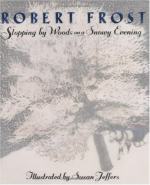|
This section contains 815 words (approx. 3 pages at 400 words per page) |

|
"Stopping By Woods on a Snowy Evening" was first published in 1923, when the pace of social growth was in the process of breaking out into a gallop. In all areas of life, new ways of looking at established ideas suddenly rose up and challenged tradition. In literature, old formal structures were redefined by the writings of James Joyce, Gertrude Stein, Ernest Hemingway, and T.S. Eliot; in art, Dadaism was a short-lived revolution but Cubism arrived to stay; mainstream architects started using the revolutionary ideas of Frank Lloyd Wright; and musicians including Louis Armstrong and Sidney Bechet invented America's indigenous music, jazz. The ideas of Darwin, Marx, Freud, and Einstein were not just the business of intellectuals anymore, but were discussed openly at dinner tables and in magazines on the grocer's rack. This sudden breakout pace of social change would naturally make people uncomfortable if they...
|
This section contains 815 words (approx. 3 pages at 400 words per page) |

|




